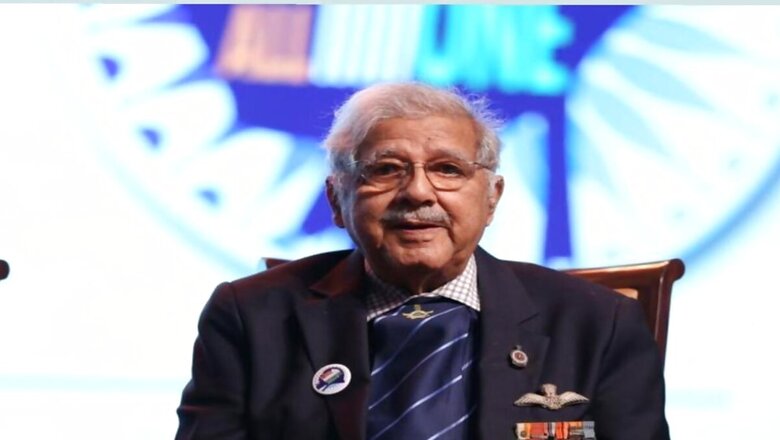
views
The Maha Vir Chakra (MVC) is the second-highest military decoration in India and is awarded for acts of conspicuous gallantry in the presence of the enemy, whether on land, in the sea or in the air. Only six officers have been awarded this medal twice. The first of the six officers to have been awarded it, twice, and that too within a span of three years was the legendary Wing Commander Jag Mohan Nath. The 96-year-old passed away at Breach Candy Hospital in Mumbai on March 21, 2023.
The son of KN Rai, Wing Commander Jag Mohan Nath, was born in Layyah, Punjab (now in Pakistan) on August 8, 1930. His family members were all doctors but he had a passion for planes from an early age. He got an opportunity to follow his passion in 1948 when he joined the Air Force Administrative College in Coimbatore for his initial training in the Indian Air Force (IAF). He had earlier studied at Government College Lahore and was commissioned as a General Duties (Pilot) in the Royal IAF on October 14, 1950.
During the Sino-India War of 1962, Squadron Leader Nath was a Flight Commander with the Strategical Reconnaissance Unit. He displayed conspicuous courage and was awarded the Maha Vir Chakra. During the 1965 Indo-Pak War, Wing Commander Jag Mohan Nath again led a Photo Reconnaissance Squadron flying the Canberra aircraft. He led his unit several times over hostile enemy territory to obtain vital information about the enemy. His courageous endeavours were vital in India’s success in the War. For his conspicuous courage and exemplary leadership, he was again awarded the Maha Vir Chakra.
He served in the IAF till 1969, then took voluntary retirement and joined Air India as a commercial pilot and then settled in Mumbai. Nath idolised the former Chief Air Staff, Air Marshal Arjan Singh and said he was a father figure who dearly cared for him and was a source of guidance for him. He dedicated his Bar to Maha Vir Chakra to Air Marshal Arjan Singh.
The role of the IAF in the 1962 conflict is significant in more ways than one. On one hand, the paucity of road communications on the Indian side of the border was such that the deployment, maintenance and even the survival of ground forces were dependent on the air supply. As the ‘Forward Policy’ came into operation in 1960, the Indian Army had to occupy forward posts and IAF were directed to carry out an assessment of aerial supply in order to establish these new posts. No 106 Squadron equipped with Canberra aircraft and fitted with cameras carried out these tasks. Initially, the mission was for mapping purposes. As the active operations started, these became recce missions to find out the deployment and strength of the Chinese. Most of these missions were in Aksai Chin, Tawang, Sela and Walong areas. During the period October 13 to November 11, 1962, the Canberras flew 22 photo recce missions, flying nearly 50 hours. Apart from these missions, there were strategic missions carried out that were controlled at the highest level.
No 106 Squadron (Lynx) was raised in 1957 in Bareilly but was moved to Agra, and its role was to provide military aerial photography and aid in other operations. The Squadron regularly made low-flying sorties, photographing all Chinese movements on the other side. In Tibet, the People’s Liberation Army (PLA) simply did not have the means to intercept these aircraft which had a free run of the skies. Wing Commander Nath, affectionately known as ‘Jaggi’, who had first photographed the Aksai Chin highway sometime in 1959, was part of this Squadron and flew his twin-engine English Electric Canberra PR 57 high-altitude long-range reconnaissance aircraft on these tough missions.
The aircraft was fitted with one camera for surveillance and four cameras for pictures. He would regularly take off from Agra cross the Karakoram Pass, then head all the way to NEFA keeping the great Himalayan Range to his right, before re–entering India along the Lohit Valley. While flying over Tibet, Xinjiang, he saw many Chinese soldiers positioned and the pictures clicked by his camera of their deployment and movement were sent directly to Air Headquarters in Delhi.
In his book ‘1962: The War That Wasn’t’, the noted military historian Shiv Kunal Verma talks about Squadron Leader Nath meeting Lieutenant General BM Kaul in Army Headquarters, with photographs of Chinese deployment after a routine sortie over Sinkiang and Tibet. “We got pictures of everything – vehicles, guns, their defences, especially in the DBO, Qara Qash and Galwan Sectors.”
Maroof Raza in his book ‘Contested Lands’ mentions that Jaggi Nath had filmed and reported the presence of Chinese soldiers in Aksai Chin stating, “I could not count them but they were there in good numbers and I took photographs.” Later, when taken to see the Defence Minister, all that Menon asked of him was, “Did you see the Chinese soldiers?” He answered, “Yes sir, I saw them.” Menon responded, “That’s all right, you can go.”
During the 1962 Sino-India War, Squadron Leader Jag Mohan Nath performed a number of risky operational missions while serving as the Flight Commander of an operational squadron, including flying over challenging mountain terrain, both during the day and at night, inclement weather, and with utter disregard for his own safety. He showed notable bravery, a strong sense of duty, and a high level of professional ability. For his gallantry, he was awarded Maha Vir Chakra.
During the 1965 Indo-Pak War, Wing Commander Nath, MVC, was the Flight Commander with No 106 Squadron, the Strategic Photo Reconnaissance Squadron flying the Canberra aircraft. As per Shiv Kunal Verma’s book ‘1965: A Western Sunrise’, “Wing Commander Jagan Mohan Nath was an unusual man who performed the most unusual tasks. With direct access to the Chief of Air Staff, at times, even his Squadron Commander was not privy to the exact task being undertaken by him.”
While there was a sense of déjà vu when, three years after the Chinese conflict, he was again asked to perform similar missions, there was a fundamental difference which made the task even more challenging. The threat of both Pakistan Air Force fighters and ground-based anti-aircraft systems existed. All his missions were done at deck level during the daytime. To avoid being picked up by Pakistani radar, he flew just above the tree top level, but as the field of view was limited, he would increase his height hoping not to be picked up by the radar and would turn on his camera and film the area.
Nath, who had earned a distinction for his heroic actions in 1962, was given the task to fly low over Pakistani territory and do aerial reconnaissance which would help the Indian Army carry out operations across the International Border. This information would enable the Army to know the positions of fortifications and bridges in the Punjab region of Pakistan, and the strength of troops and record their movements.
Nath is credited with filming the Ichhogil Canal to check Pakistani buildup around Lahore during this conflict. Getting airborne from Agra, he entered Pakistani airspace opposite Pathankot, and flew along the canal. His sortie literally chartered the canal. He led his unit several times over hostile territory to obtain vital information about the enemy. The unescorted missions, which were in the nature of reconnaissance, entailed flying long distances over enemy territory and well-defended airfields and installations during daylight. On each of these missions, Wing Commander Nath was completely aware of the risk he was taking. Yet, he opted to carry on the perilous missions by himself. He only gave his colleagues permission to complete some dangerous tasks after much convincing.
The data he obtained throughout his trips turned out to be crucial for the IAF. The sorties gave IAF the ability to attack crucial enemy objectives, which caused adverse damage to enemy war effort. Wing Commander Nath received the Bar from Mahavir Chakra for exhibiting bravery, tenacity, and devotion to duty.
There is no doubt that the meticulous mapping of the adversaries’ terrain, deployment and movement by Wing Commander Jaggi Nath in both conflicts was an outstanding feat. The information gathered by him during his missions proved vital to Indian efforts during the wars. The missions in 1965 enabled our Air Force to attack key enemy targets and this adversely affected the enemy’s war effort.
Wing Commander Jaggi Nath was married to Usha and is survived by his two children, a son Sanjiv Malhotra and a daughter Arti Vakil. His was an achievement that had few parallels in the military.
The author is an Army veteran. The views expressed in this article are those of the author and do not represent the stand of this publication.
Read all the Latest Opinions here















Comments
0 comment